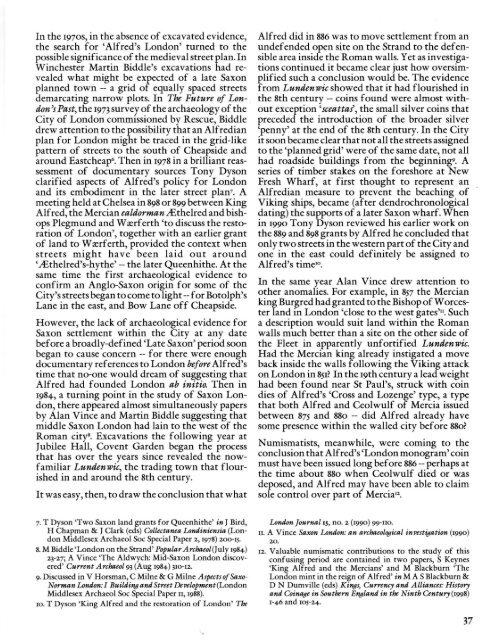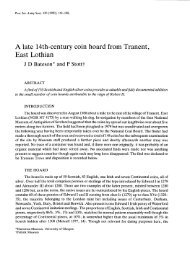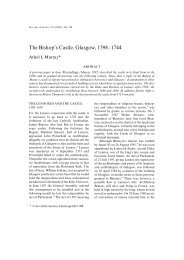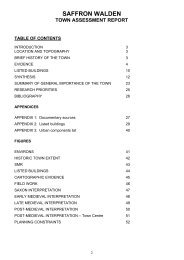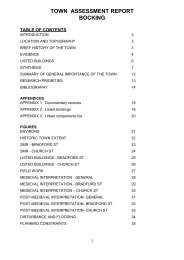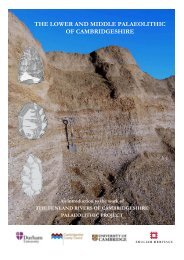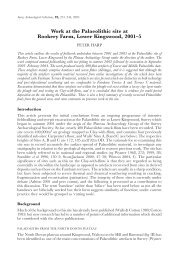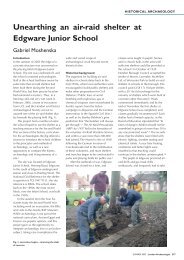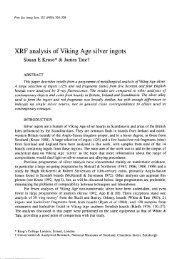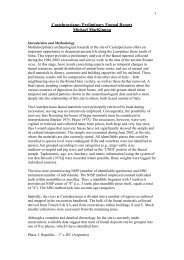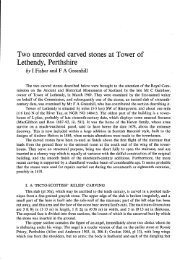King Alfred's London and London's King Aifred
King Alfred's London and London's King Aifred
King Alfred's London and London's King Aifred
Create successful ePaper yourself
Turn your PDF publications into a flip-book with our unique Google optimized e-Paper software.
In the 1970S, in the absence of excavated evidence,<br />
the search for '<strong>Alfred's</strong> <strong>London</strong>' turned to the<br />
possible significanceof the medieval streetplan. In<br />
Winchester Martin Biddle's excavations had revealed<br />
what might be expected of a late Saxon<br />
planned town -- a grid of equally spaced streets<br />
demarcating narrow plots. In The Future of <strong>London</strong>'sPast,<br />
the 1973 surveyof thearchaeologyof the<br />
City of <strong>London</strong> commissioned by Rescue, Biddle<br />
drew attention to the possibility that an Alfredian<br />
plan for <strong>London</strong> might be traced in the grid-like<br />
pattern of streets to the south of Cheapside <strong>and</strong><br />
around Eastcheaps. Then in 1978 in a brilliant reassessment<br />
of documentary sources Tony Dyson<br />
clarified aspects of <strong>Alfred's</strong> policy for <strong>London</strong><br />
<strong>and</strong> its embodiment in the later street planz, A<br />
meeting held at Chelsea in 898 or 899between <strong>King</strong><br />
Alfred, the Mercian ealdorman LEthelred <strong>and</strong> bishops<br />
Plegmund <strong>and</strong> Wa::rferth 'to discuss the restoration<br />
of <strong>London</strong>', together with an earlier grant<br />
of l<strong>and</strong> to Wa::rferth, provided the context when<br />
streets might have been laid out around<br />
'LEthelred's-hythe' -- the later Queenhithe. At the<br />
same time the first archaeological evidence to<br />
confirm an Anglo-Saxon origin for some of the<br />
City'sstreets began tocometo light--for Botolph's<br />
Lane in the east, <strong>and</strong> Bow Lane off Cheapside.<br />
However, the lack of archaeological evidence for<br />
Saxon settlement within the City at any date<br />
before a broadly-defined 'Late Saxon' period soon<br />
began to cause concern -- for there were enough<br />
documentary references to <strong>London</strong> before<strong>Alfred's</strong><br />
time that no-one would dream of suggesting that<br />
Alfred had founded <strong>London</strong> ab initio. Then in<br />
1984-, a turning point in the study of Saxon <strong>London</strong>,<br />
there appeared almost simultaneously papers<br />
by Alan Vince <strong>and</strong> Martin Biddle suggesting that<br />
middle Saxon <strong>London</strong> had lain to the west of the<br />
Roman city", Excavations the following year at<br />
Jubilee Hall, Covent Garden began the process<br />
that has over the years since revealed the nowfamiliar<br />
Lundenwic, the trading town that flourished<br />
in <strong>and</strong> around the 8th century.<br />
It was easy, then, to draw the conclusion that what<br />
7. T Dyson 'Two Saxon l<strong>and</strong> grants for Queenhithe' in J Bird,<br />
H Chapman & J Clark (eds) Collectanea Londiniensia (<strong>London</strong><br />
Middlesex Archaeol Sac Special Paper 2, 1978) 200-15.<br />
8.M Biddle '<strong>London</strong> on theStr<strong>and</strong>' Popular Archaeol(July 1984-)<br />
23-27; A Vince 'The Aldwych: Mid-Saxon <strong>London</strong> discovered<br />
' Current Archaeol93 (Aug 1984-) 310-12.<br />
9. Discussed in V Horsman, C Milne & G Milne Aspects of SaX()<br />
Norman <strong>London</strong>:I Building<strong>and</strong>Street Development(<strong>London</strong><br />
Middlesex Archaeol Soc Special Paper 11, 1988).<br />
10. T Dyson '<strong>King</strong> Alfred <strong>and</strong> the restoration of <strong>London</strong>' The<br />
Alfred did in 886 was to move settlement from an<br />
undefended open site on the Str<strong>and</strong> to the defensible<br />
area inside the Roman walls. Yet as investigations<br />
continued it became clear just how oversimplified<br />
such a conclusion would be. The evidence<br />
from Lundenwic showed that it had flourished in<br />
the 8th century -- coins found were almost without<br />
exception 'sceattas', the small silver coins that<br />
preceded the introduction of the broader silver<br />
'penny' at the end of the 8th century. In the City<br />
itsoon became clear thatnot all the streets assigned<br />
to the 'planned grid' were of the same date, not all<br />
had roadside buildings from the beginnings, A<br />
series of timber stakes on the foreshore at New<br />
Fresh Wharf, at first thought to represent an<br />
Alfredian measure to prevent the beaching of<br />
Viking ships, became (after dendrochronological<br />
dating) the supports of a later Saxon wharf. When<br />
in 1990 Tony Dyson reviewed his earlier work on<br />
the 889 <strong>and</strong> 898grants by Alfred he concluded that<br />
only twostreets in the western partof the City <strong>and</strong><br />
one in the east could definitely be assigned to<br />
<strong>Alfred's</strong> time>.<br />
In the same year Alan Vince drew attention to<br />
other anomalies. For example, in 857 the Mercian<br />
king Burgred hadgranted tothe BishopofWorcester<br />
l<strong>and</strong> in <strong>London</strong> 'close to the west gates". Such<br />
a description would suit l<strong>and</strong> within the Roman<br />
walls much better than a site on the other side of<br />
the Fleet in apparently unfortified Lundenwic.<br />
Had the Mercian king already instigated a move<br />
back inside the walls following the Viking attack<br />
on <strong>London</strong> in 851? In the roth century a lead weight<br />
had been found near St Paul's, struck with coin<br />
dies of <strong>Alfred's</strong> 'Cross <strong>and</strong> Lozenge' type, a type<br />
that both Alfred <strong>and</strong> Ceolwulf of Mercia issued<br />
between 875 <strong>and</strong> 880 -- did Alfred already have<br />
some presence within the walled city before 880?<br />
Numismatists, meanwhile, were coming to the<br />
conclusion that <strong>Alfred's</strong> '<strong>London</strong> monogram'coin<br />
must have been issued long before 886 -- perhaps at<br />
the time about 880 when Ceolwulf died or was<br />
deposed, <strong>and</strong> Alfred may have been able to claim<br />
sole control over part of Merciav.<br />
<strong>London</strong> Journal 15, no. 2 (1990) 99-110.<br />
11. A Vince Saxon <strong>London</strong>: an archaeological investigation (1990)<br />
20.<br />
12. Valuable numismatic contributions to the study of this<br />
confusing period are contained in two papers, S Keynes<br />
'<strong>King</strong> Alfred <strong>and</strong> the Mercians' <strong>and</strong> M Blackburn 'T he<br />
<strong>London</strong> mint in the reign of Alfred' in M A S Blackburn &<br />
D N Dumville (eds) <strong>King</strong>s, Currency <strong>and</strong> Alliances: History<br />
<strong>and</strong> Coinage in Southern Engl<strong>and</strong> in the Ninth Century (1998)<br />
1-4-6 <strong>and</strong> 105-24-.<br />
37


